Service history
The research vessel was constructed at Seaspan Shipyard, Vancouver, British Columbia and launched on 5 June 2019. [6] The sister ship of CCGS Sir John Franklin and CCGS John Cabot, Capt. Jacques Cartier was named for Jacques Cartier, the French explorer who was the first European to land on the shores of the St. Lawrence River. [5] After sea trials, Capt. Jacques Cartier will be assigned to the Canadian Coast Guard base at Dartmouth, Nova Scotia. [6] Sea trials began on 10 October 2019. [7] The vessel completed sea trials and was handed over to the Canadian Coast Guard on 11 December 2019. Capt. Jacques Cartier is home ported at Dartmouth, Nova Scotia. [8]
However, after arriving in Nova Scotia, the vessel has been beset by a series of problems that have prevented Capt. Jacques Cartier from becoming operational. A series of malfunctions with the winches, sensors and engines, a shortage of spare parts and issues related to the COVID-19 pandemic have stopped the ship from performing the training and trials needed to be fully operational. [9]
In June 2022, the ship began a planned maintenance period that included replacing bearings in a stern propeller tube that allows the propeller to turn smoothly. The problem was assessed as one common to all three vessels in the class. The refit was then extended by two months to address other issues. The extended refit was reported as unlikely to impact upcoming science programs on Capt. Jacques Cartier. [10]

CCGS Amundsen is a Pierre Radisson-class icebreaker and Arctic research vessel operated by the Canadian Coast Guard. The vessel entered service in 1979 as Franklin and was renamed Sir John Franklin in 1980 and served as such until 1996. Declared surplus, the vessel was used as an accommodation ship in Labrador in 1996 and placed in reserve in 2000. In 2003, the ship was reactivated and underwent conversion to an Arctic research vessel. The ship recommissioned as Amundsen.

CCGS Sir Wilfred Grenfell is a Canadian Coast Guard vessel based in Victoria, British Columbia. Designated an "Offshore Ice Strengthened Multi Patrol Vessel", the former offshore supply vessel is named after the medical missionary in Labrador, Sir Wilfred Grenfell. Constructed in 1984–1985, Sir Wilfred Grenfell was purchased by the Canadian Government and converted for Coast Guard service. In 1994, she played an important role in the fishing conflict known as the Turbot War in the Atlantic Ocean.
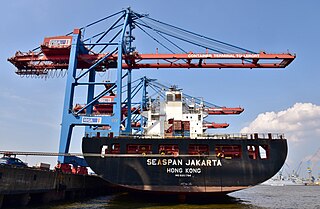
Seaspan ULC provides marine-related services to the Pacific Northwest. Within the Group are three (3) shipyards, an intermodal ferry and car float business, along with a tug and barge transportation company that serves both domestic and international markets. Seaspan, is part of the Washington Companies that are owned by Dennis Washington. Kyle Washington, is the Executive Chairman of Seaspan, who has become a Canadian citizen.
The Protecteur class of naval auxiliaries for the Royal Canadian Navy (RCN) began as the Joint Support Ship Project, a Government of Canada procurement project for the RCN that is part of the National Shipbuilding Procurement Strategy. It will see the RCN acquire two multi-role vessels to replace the earlier Protecteur-class auxiliary oiler replenishment vessels.
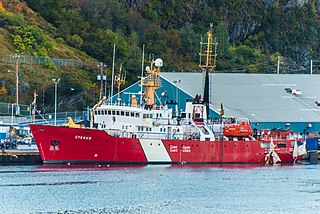
CCGS Cygnus is a Cape Roger-class fisheries patrol vessel of the Canadian Coast Guard. The ship entered service in 1981 and is used to monitor the fisheries along the Atlantic coast of Canada. During the Turbot War, Cygnus was among the Coast Guard vessels sent to monitor the European fishing fleet on the Grand Banks.
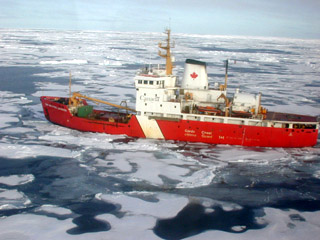
CCGS Sir Wilfrid Laurier is a Martha L. Black-class light icebreaker and major navaids tender of the Canadian Coast Guard. Built in 1986 by Canadian Shipbuilding at Collingwood, Ontario, Canada, she was the last ship constructed there. The ship has been based out of Victoria, British Columbia.
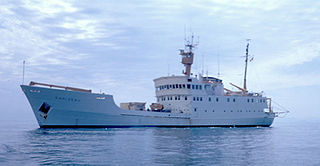
CCGS Parizeau was a Canadian Coast Guard research vessel that served from 1967 to 2001. Initially serving on the West Coast of Canada from 1967 to 1991, in 1992, the ship transferred to the East Coast of Canada. Taken out of service in 2004, the ship was later sold and converted to a yacht and unsuccessfully used for drug smuggling as Destiny Empress.

CCGS Hudson was an offshore oceanographic and hydrographic survey vessel operated by the Canadian Coast Guard. The ship entered service in 1963 with the Canadian Oceanographic Service, stationed at the Bedford Institute of Oceanography, called CSS Hudson. The ship made several significant scientific voyages, among them the first circumnavigation of the Americas in 1970. The ship was transferred to the Canadian Coast Guard in 1996 and decommissioned in 2022. A replacement is not scheduled for delivery until 2024–2025.
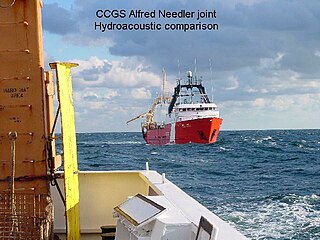
CCGS Alfred Needler is an offshore fishery science vessel formerly operated by the Canadian Coast Guard. The vessel entered service in 1982 with the Department of Fisheries and Oceans, stationed at the Bedford Institute of Oceanography in Dartmouth, Nova Scotia. In 1995, in order to reduce the number of ships and combine tasks, the Fisheries and Oceans fleet and the Canadian Coast Guard fleets were merged under the Canadian Coast Guard. The ship was decommissioned from Canadian Coast Guard service in 2023.

Burrard Dry Dock Ltd. was a Canadian shipbuilding company headquartered in North Vancouver, British Columbia. Together with neighbouring North Van Ship Repair and Yarrows Ltd. of Esquimalt, which were both later purchased by the company, Burrard built and refitted over 450 ships, including many warships for the Royal Navy and Royal Canadian Navy during the First and Second World Wars.

Davie Shipbuilding is a shipbuilding company located in Lauzon, Quebec, Canada. The facility is now operating as Chantier Davie Canada Inc. and is the oldest continually operating shipbuilder in North America.

CCGS Arpatuuq is a future Canadian Coast Guard icebreaker that will be built under the Polar Icebreaker Project as part of the National Shipbuilding Strategy. The ship was initially expected to join the fleet by 2017 but has been significantly delayed and is now expected by 2030.
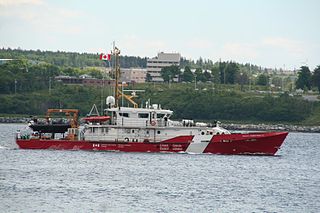
The Hero-class patrol vessels, previously the Mid-Shore Patrol Vessel Project, is a series of nine patrol vessels constructed by Halifax Shipyards for the Canadian Coast Guard. Based on the Dutch Damen Stan 4207 patrol vessel, construction began in 2011 and the first vessel entered service in 2012. The vessels are assigned to the Atlantic and Pacific coasts of Canada, used for coastal patrol duties.

CCGS Earl Grey is a Samuel Risley-class light icebreaker and buoy tender in the Canadian Coast Guard. Constructed in 1986, the vessel serves a variety of roles, including light ice-breaking and buoy tending, as well as being strengthened for navigation in ice to perform tasking along the shores off the Atlantic coast of Canada. Like her sister ship, CCGS Samuel Risley, she carries a large and powerful crane on her long low afterdeck for manipulating buoys. Earl Grey is the second icebreaker in Canadian service to carry the name.
The National Shipbuilding Strategy (NSS), formerly the National Shipbuilding Procurement Strategy (NSPS), is a Government of Canada program operated by the Department of Public Works and Government Services. The NSS was developed under the Stephen Harper Government in an effort to renew the fleets of the Royal Canadian Navy (RCN) and the Canadian Coast Guard (CCG). The strategy was broken into three sections; the combat package, the non-combat package and the smaller vessel package. The companies who won the bids for the larger ships were not permitted to bid on the smaller vessel package. In 2019, the Trudeau Government decided to add a third shipyard to the NSS specializing in the construction of icebreakers for the Coast Guard. The agreement to incorporate Davie as a third shipyard within the NSS was finally signed in April 2023.
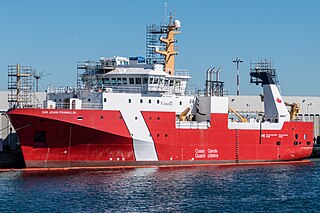
CCGS Sir John Franklin is an offshore fisheries research ship of the Canadian Coast Guard. The ship was ordered in 2011 as part of the Canadian National Shipbuilding Procurement Strategy (NSPS) as a replacement for aging Canadian Coast Guard vessels. The ship was launched on 8 December 2017, named for Sir John Franklin, an arctic explorer who led two Royal Navy expeditions in search of the Northwest Passage, the second ending with the death of all his crew around 1848. The first of three vessels, Sir John Franklin is the sister ship of CCGS Capt. Jacques Cartier and CCGS John Cabot.
CCGS John Cabot is a Canadian Coast Guard offshore fisheries research ship. The vessel was constructed in 2020 by Vancouver Shipyards, operated by Seaspan Shipyards, in North Vancouver, British Columbia. It is named after John Cabot, an Italian explorer. John Cabot's home port is St. John's, Newfoundland and Labrador.

The Polar Icebreaker Project is an ongoing Canadian shipbuilding program under the National Shipbuilding Strategy. Announced in 2008 with an intention to replace the ageing CCGS Louis S. St-Laurent with a new polar icebreaker by 2017, the program has faced multiple delays and changes, and as of 2024 consists of two planned icebreakers, CCGS Arpatuuq and CCGS Imnaryuaq, with the first vessel expected to enter service in 2030.
CCGS Naalak Nappaaluk is a future offshore oceanographic and hydrographic survey vessel for the Canadian Coast Guard. The vessel is scheduled to replace CCGS Hudson.















